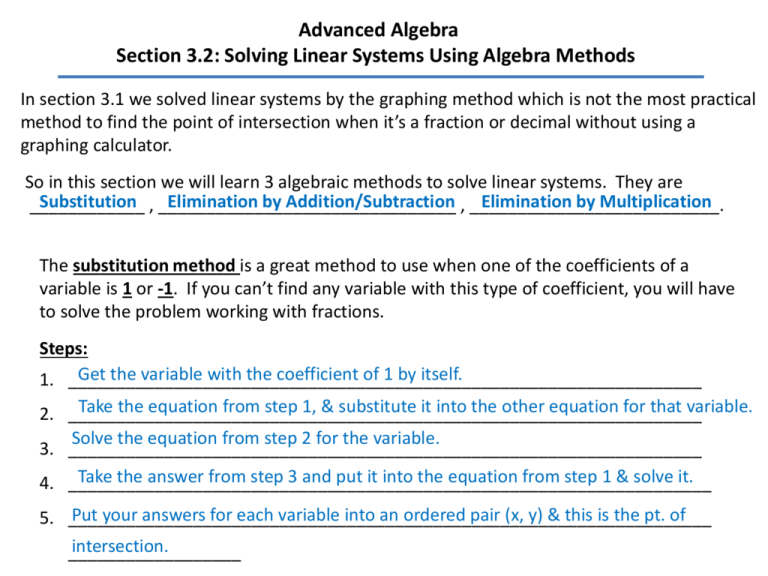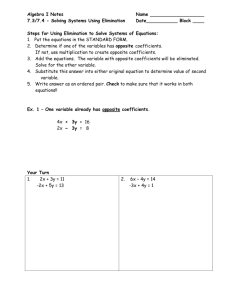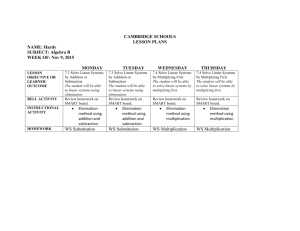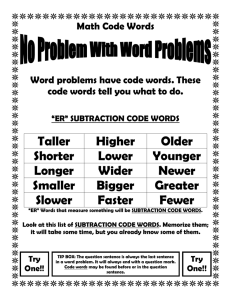Notes 3.2
advertisement

Advanced Algebra Section 3.2: Solving Linear Systems Using Algebra Methods In section 3.1 we solved linear systems by the graphing method which is not the most practical method to find the point of intersection when it’s a fraction or decimal without using a graphing calculator. So in this section we will learn 3 algebraic methods to solve linear systems. They are Substitution , _______________________________ Elimination by Addition/Subtraction , __________________________. Elimination by Multiplication ____________ The substitution method is a great method to use when one of the coefficients of a variable is 1 or -1. If you can’t find any variable with this type of coefficient, you will have to solve the problem working with fractions. Steps: Get the variable with the coefficient of 1 by itself. 1. __________________________________________________________________ Take the equation from step 1, & substitute it into the other equation for that variable. 2. __________________________________________________________________ Solve the equation from step 2 for the variable. 3. __________________________________________________________________ Take the answer from step 3 and put it into the equation from step 1 & solve it. 4. ___________________________________________________________________ Put your answers for each variable into an ordered pair (x, y) & this is the pt. of 5. ___________________________________________________________________ intersection. __________________ Examples: Solve the system . 1. y = 2x 2x + 5y = -12 2x + 5(2x) = -12 2x + 10x = -12 y = 2x y = 2(-1) 12x = -12 y = -2 12 12 x = -1 (-1, -2) pt. of intersection 2. x+y=6 3x + y = 15 x+y=6 -y -y x = -y + 6 3(-y + 6) + y = 15 xy6 -3y + 18 + y = 15 3 x 6 2 -2y + 18 = 15 -18 -18 3 12 x 2 2 -2y = -3 -2 y -2 3 2 x 9 2 9 3 , pt. of int er sec tion 2 2 Elimination by Addition/Subtraction method when the coefficients of either We will use the _______________________________ the x or y variables are opposites or the same number. EX: x – 4y = 6 3x + 4y = 10 ** The coefficients of the of the y variables are opposites of each other. Eliminate by Addition! 6x + 5y = 4 6x – 7y = -20 ** The coefficients of the x variables are the same numbers. Eliminate by Subtraction! Examples: 3. Solve the linear system. -3x + 4y = 12 3x - 4y = -18 Coefficients of the x & y variables are opposites, Eliminate by Addition. 3 x 4 y 12 3 x 4 y 18 0 6 Lines are parallel. 4. 3x + y = 6 4x + y = 7 The coefficients of the y variable are the same, Eliminate by Subtraction. 3x y 6 4x y 7 3x y 6 3x y 6 4 x y 7 x 1 1 1 x 1 3(1) y 6 3 y 6 3 3 y 3 1,3 elimination by We will use our last algebraic method to solve a linear system which is ___________ multiplication ______________. Steps: 1. Pick one of the variables that you want to elimination. 2. Multiply one or both of the equations by a number so that the coefficients of one of the variables will be opposites or the same. 3. Solve the rest of the problem like we did with addition/subtraction method. Example: 5. Solve the linear system. 3x + 5y = 11 2x + 3y = 7 2x 3y 7 2 x 3(1) 7 2x 3 7 3 3 2x 4 2 2 2 3x 5 y 11(2) 6 x 10 y 22 3(2 x 3 y) 7(3) 6 x 9 y 21 y 1 Solution: (2,1) x2 6. 3x – y = 2 x + 2y = 3 2(3x y ) 2(2) 6x 2 y 4 x 2y 3 x 2y 3 7x 7 7 7 x 1 (1,1) x 2y 3 1 2 y 3 1 1 2y 2 2 2 y 1 Lesson 3.2 Practice C in the packet: 1-20 all






